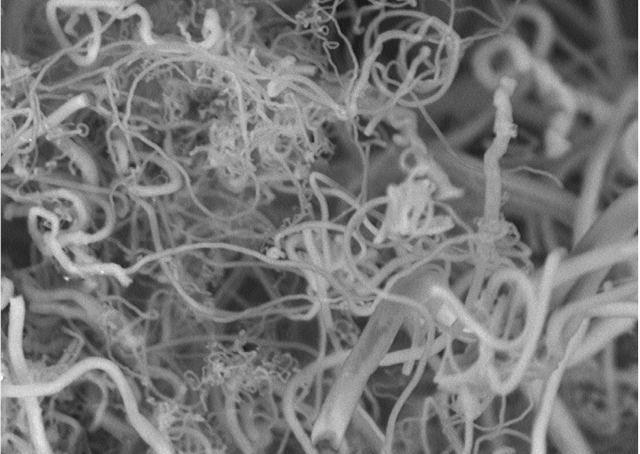A new chemical technology, promising to convert captured atmospheric CO2 into high-quality carbon nanofibers, was presented at the 2015 ACS National Meeting and Exposition.
 Researchers are generating carbon nanofibers (above) from CO2, removing a greenhouse gas from the air to make products. Stuart Licht.
Researchers are generating carbon nanofibers (above) from CO2, removing a greenhouse gas from the air to make products. Stuart Licht.
Carbon dioxide (CO2) is an anthropogenic greenhouse gas, which is a significant contributor to climate change. Naturally, any technology which can turn this problematic component of our atmosphere into a valuable commodty would be extremely attractive to scientists and governments alike.
Now, researchers at George Washington University may have found just such a technology.
We have found a way to use atmospheric CO2 to produce high-yield carbon nanofibers. Such nanofibers are used to make strong carbon composites, such as those used in the Boeing Dreamliner, as well as in high-end sports equipment, wind turbine blades and a host of other products.
Stuart Licht, PhD, Lead Researcher
Licht has referred to this method as “diamonds from the sky” - referring to the fact that his nanofibers and diamond are both made from carbon, and the high value of the products that can be manufactured from atmospheric carbon.
This process, which utilizes electrolytic synthesis, is highly energy efficient. All it requires is sunlight, low-voltage electricity, and plenty of CO2.
The electrolytic synthesis Licht's team developed involves using an electrolytic bath of molten carbonates at 1,380°F (750°C), with nickel and steel electrodes. This is a relatively low temperature compared to some industrial electrolytic processes, such as aluminum extraction.
Normal atmospheric air is added to this electrolytic cell, and the CO2 dissolves and is broken down by the combination of high temperature and direct current. The carbon nanofibers gradually build up on the steel electrode, from where they can be easily removed.
The researchers also used a concentrating solar energy system to provide both heating and electricity for the synthesis. Overall, the process is estimated to cost around $1,000 per ton of carbon nanofiber produced - several hundred times less than the typical value of the product.
We calculate that with a physical area less than 10 percent the size of the Sahara Desert, our process could remove enough CO2 to decrease atmospheric levels to those of the pre-industrial revolution within 10 years
Stuart Licht, PhD
The team is now working on the challenge of scaling this process up to manufacturing scale, as well as improving the consistency in size and properties of the nanofibers produced. Licht predicted that they would soon be capable of producing tens of grams of nanofibers per hour.
The National Science Foundation has provided the primary funding for this study.
Watch Stuart Licht's presentation at the ACS National Meeting and Exposition in Boston:
Diamonds from the sky’ approach turns CO2 into valuable products
References and further reading
‘Diamonds from the sky’ approach turns CO2 into valuable products - ACS Newsroom